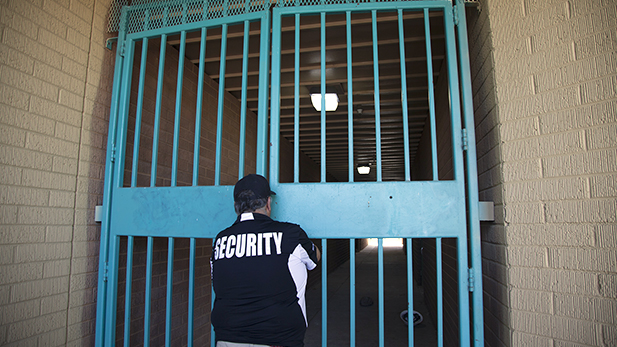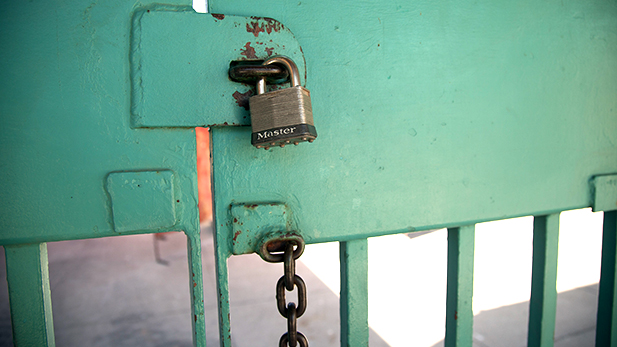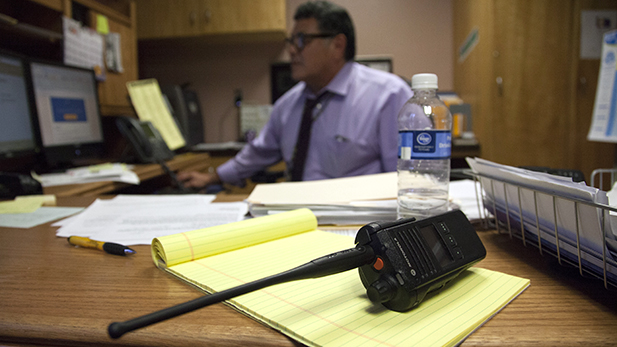 Construction is underway to transform Chaparral Middle School to the new Gallego Fine Arts Magnet school, which will serve grades 5-8 in the 15-16 school year.
Construction is underway to transform Chaparral Middle School to the new Gallego Fine Arts Magnet school, which will serve grades 5-8 in the 15-16 school year. Listen:
The Sunnyside Unified School District's new fine arts magnet school is set to open in the fall, grades four to eight.
The district is renovating the old Chaparral Middle School to include a music lab with an orchestra’s worth of new instruments and an art studio.
A more subtle upgrade is the installment of bullet-resistant glass in the front office.
“It’s not going to look any different than any other plate glass, but it will be more resistant,” said Francisco Morales, Sunnyside’s director for school safety. “It’s kind of like what banks do.”
The school will be the first in the district to have bullet-resistant glass. Upgrading school safety infrastructure in Sunnyside and other area school districts has been a piecemeal process.
Years-long reductions in capital spending mean most improvements are funded by voter-approved loans and budget overrides or grants.
Upgrades have included new security fencing, automatic door locks, ID scanners and more law enforcement officers on campuses.
“Schools weren’t designed like prisons to keep people out,” Morales said. “They’re inviting. We want to bring people in, but at the same time we have to think about what is going to be safe and orderly for our students and staff.”

Morales started at the Sunnyside district in 1992, as a juvenile probation officer stationed at a school. It was the same year a teenage student was shot and killed in the Desert View High School parking lot.
“Once that happened, then the fences started to go up and the district had to pass an override to get monies to do that,” Morales said.
The event also prompted an increased number of police officers assigned to schools and the installation of security monitors. Now, Sunnyside has about 600 security cameras district-w ide and burglar alarms.
Guests visiting any district school check in with a security guard in the parking lot.
The bulletproof glass is new to the district, and Sunnyside is the only one of the six local districts that responded to Arizona Public Media’s requests for information about school safety that said they are using the material.
Budget documents show it will cost $10,000 to install the glass in the front office. The creation of the fine arts school is paid for by a bond. Bonds for borrowing and budget overrides allow districts to increase taxes temporarily to meet specific spending needs and must be voter-approved.
As state funding has decreased, districts rely on these changes to fund not special projects and routine improvements.
Morales said the installation is the district’s push to “harden the target,” which means make schools less attractive to would-be criminals.
“We have to make sure we are always vigilant and always making things a little more difficult for bad guys to come in to,” Morales said.
 Director for School Safety Francisco Morales said Sunnyside's radio system allows the district to interact directly with local law enforcement.
Director for School Safety Francisco Morales said Sunnyside's radio system allows the district to interact directly with local law enforcement. Listen:
Amphitheater School District is another that is using money from a voter-approved loan to boost school safety.
Visitors to Amphitheater Middle School enter through a glass walkway and doors are unlocked remotely by staff in the front office.
“If it’s someone we don’t want to come on to campus we can push the button and can call 911 immediately,” said Principal Tassi Call.
The school also has iron fencing that closes off the majority of the campus during the school day.
The improvements at Amphitheater Middle School were funded by taxpayers through a 2007 bond election.
The fencing at Amphi Middle cost almost $70,000. Fence upgrades for high schools were even more expensive. Canyon Del Oro’s was $102,000.
Normally, these kind of expenditures would come from state capital funding.
“Our capital this year is pretty dismal when you look at what they gave us with one hand and took away with the other,” said District spokeswoman Mindy Blake. “We are looking at being left with about $74,000 next year in capital for the district.”
Put another way, even if the district chose to drop everything else it paid for with state funds such as textbooks, furniture computers, it could upgrade one school’s fencing per year.
“We do what we can with the funds we have right now,” Blake said.
For most districts, this means their school security plans include many parts. At Sunnyside, security staff uses radios to keep in touch with each other and local law enforcement.
That system needs to be upgraded because of a change to federal regulations, Morales said.
“We’ve been doing that little by little, but it’s very expensive,” Morales said.
What’s happening at other local schools?
Marana Unified School District - All schools have security cameras, but some locations are adding more as part of a $2 million bond project. By the end of the project, there will be 629 cameras in the district.
Flowing Wells School District - There have been no recent improvements, except for one elementary school with a buzz-in system for the front door, said Superintendent David Baker.
Tucson Unified School District - Lynn-Urquides Elementary School and Doolen Middle School installed $441,000 in fencing upgrades in 2013. In the same year, a bond project also funded the installment of card readers for $1.2 million.
Vail School District - The district is looking into upgrades, but likely won’t make any purchases until 2017 when more bond money is available, said district spokesperson Natalie Luna Rose.

By submitting your comments, you hereby give AZPM the right to post your comments and potentially use them in any other form of media operated by this institution.